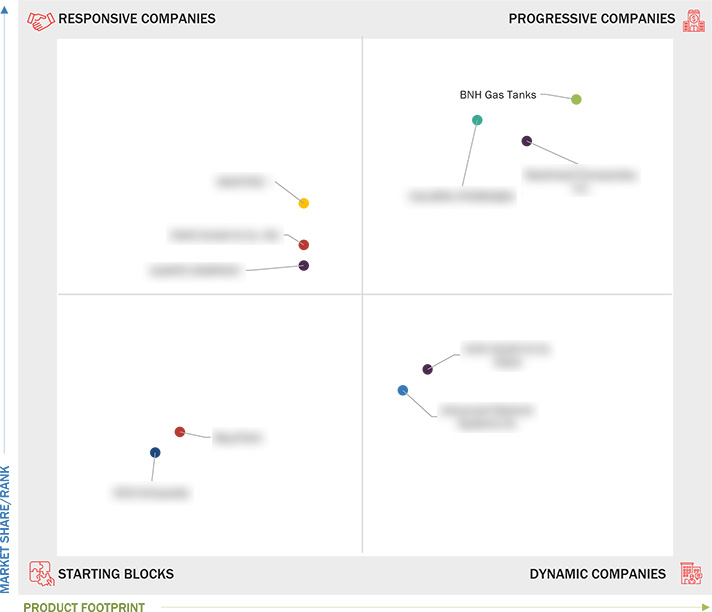Comparing 10 vendors in Hydrogen Tanks Startups across 0 criteria.
A hydrogen tank can be considered a storage vessel designed for holding or storing hydrogen gas either at low or high temperatures. Hydrogen tank materials mainly consist of carbon fiber , glass fiber, metal, or composite materials. Overall, the choice and preference of materials depends on the applications and required properties and characteristics, including weight, capacity, pressure, and cost. The market covers hydrogen storage tanks used to store hydrogen in gaseous form for stationary and mobile applications. Stationary hydrogen storage tanks in the form of bundles and cascades are used to store hydrogen gas in hydrogen refueling stations and in chemical, medical & pharmaceutical, and other industries.
Market Leadership Quadrant
1.1 Study Objectives
1.2 Market Definition
1.3 Study Scope
1.3.1 Markets Covered and Regional Scope
1.3.2 Inclusions and Exclusions
1.3.3 Years Considered
1.4 Currency Considered
1.5 Unit Considered
1.6 Limitations
1.7 Stakeholders
2.1 Introduction
2.2 Market Dynamics
2.2.1 Drivers
2.2.1.1 Growing demand for clean energy solutions
2.2.1.2 Increasing demand for hydrogen fuel-cell vehicles
2.2.1.3 Growing government investments & initiatives
2.2.2 Restraints
2.2.2.1 High cost of composite-based tanks
2.2.2.2 Safety concerns and regulations
2.2.3 Opportunities
2.2.3.1 Growing adoption of hydrogen tanks in the military and defense sector
2.2.3.2 Emergence of lightweight composite material-based hydrogen tanks
2.2.4 Challenges
2.2.4.1 Lack of hydrogen refueling stations
2.2.4.2 Capital-intensive production
2.3 Trends/Disruptions Impacting Customer Business
2.4 Value Chain Analysis
2.5 Ecosystem Analysis
2.6 Investment and Funding Scenario
2.7 Technology Analysis
2.7.1 Key Technologies
2.7.2 Complementary Technologies
2.7.3 Adjacent Technologies
2.8 Patent Analysis
2.9 Trade Analysis
2.10 Porter’s Five Forces Analysis
2.10.1 Threat of New Entrants
2.10.2 Threat of Substitutes
2.10.3 Bargaining Power of Suppliers
2.10.4 Bargaining Power of Buyers
2.10.5 Intensity of Competitive Rivalry
3.1 Introduction
3.2 Key Player Strategies/Right to Win
3.3 Revenue Analysis
3.4 Market Share Analysis
3.5 Company Valuation and Financial Metrics
3.6 Brand/Product Comparison
3.7 Company Evaluation Matrix: Startups/SMEs
3.7.1 Progressive Companies
3.7.2 Responsive Companies
3.7.3 Dynamic Companies
3.7.4 Starting Blocks
3.7.5 Competitive Benchmarking: Startups/SMEs
3.7.5.1 Detailed list of key startups/SMEs
3.7.5.2 Competitive benchmarking of key startups/SMEs
3.8 Competitive Scenario
3.8.1 Product Launches
3.8.2 Deals
4.1 BNH GAS TANKS LLP
4.1.1 Business overview
4.1.2 Products/Solutions/Services offered
4.1.3 Recent developments
4.2 CALVERA HYDROGEN S.A.
4.2.1 Business overview
4.2.2 Products/Solutions/Services offered
4.2.3 Recent developments
4.3 STEELHEAD COMPOSITES, INC
4.3.1 Business overview
4.3.2 Products/Solutions/Services offered
4.3.3 Recent developments
4.4 MAHYTEC
4.4.1 Business overview
4.4.2 Products/Solutions/Services offered
4.4.3 Recent developments
4.5 VAKO GmbH & Co. KG
4.5.1 Business overview
4.5.2 Products/Solutions/Services offered
4.5.3 Recent developments
4.6 ALSAFE COMPANY
4.6.1 Business overview
4.6.2 Products/Solutions/Services offered
4.6.3 Recent developments
4.7 VOITH GMBH
4.7.1 Business overview
4.7.2 Products/Solutions/Services offered
4.7.3 Recent developments
4.8 Advanced Material Systems Co.
4.8.1 Business overview
4.8.2 Products/Solutions/Services offered
4.8.3 Recent developments
4.9 BAYOTECH
4.9.1 Business overview
4.9.2 Products/Solutions/Services offered
4.9.3 Recent developments
4.10 ECS Composite
4.10.1 Business overview
4.10.2 Products/Solutions/Services offered
4.10.3 Recent developments


 Fuel Cells Works
Fuel Cells Works
 Oct 2025
Oct 2025

